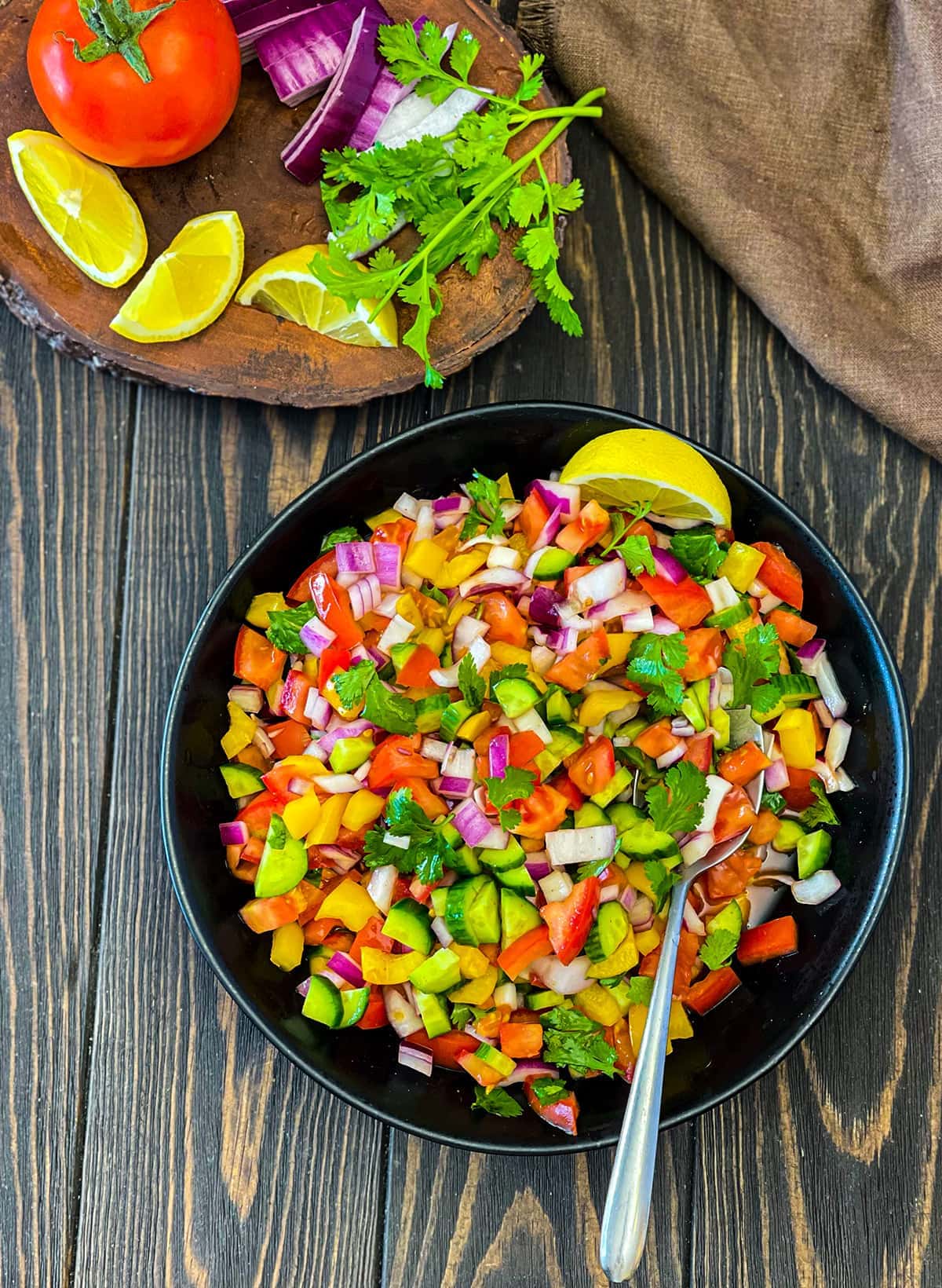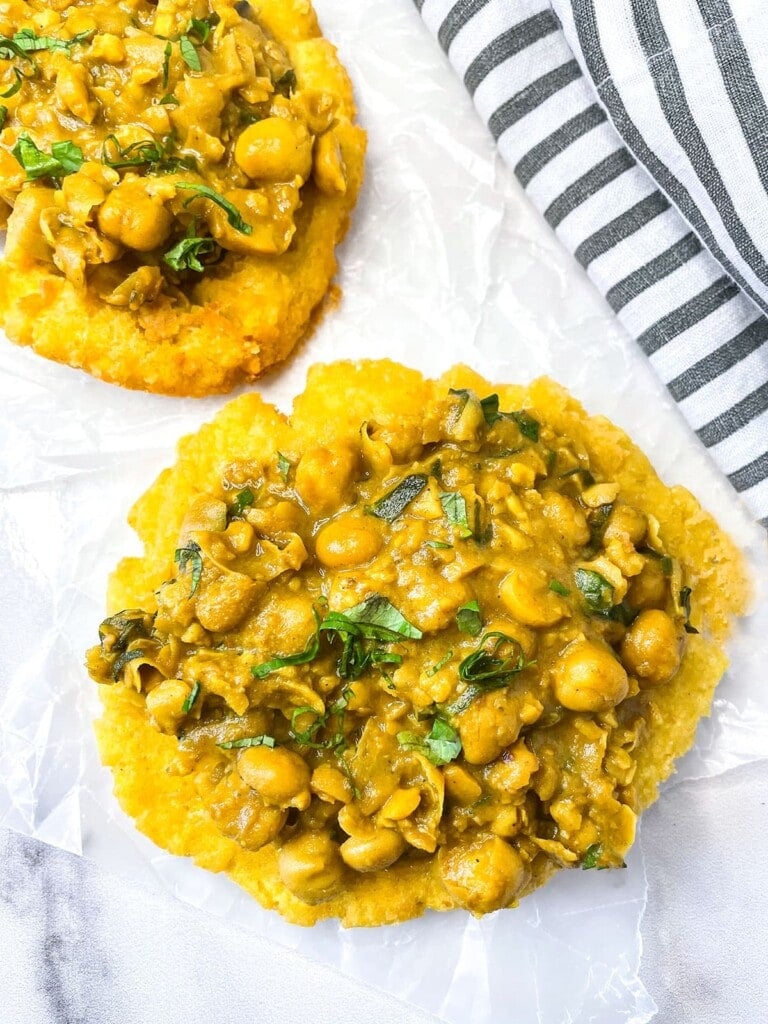Kachumbari
Kachumbari is an African salad. The name kachumbari originated from Indian cuisine which is a salad made from chopped tomato, onion cucumber. This salad is popular all over Africa.
Africa, it is consumed in some of the countries such as the east African ones and part of the southern African countries.
In Kenya, it is very common in the western region and coastal part mainly alongside the sea dishes. Usually, kachumbari is often a side dish served along with the main meal. It is easy to prepare because it does not require heating or cooking it is consumed in its raw form. The Kenyan kachumbari has tomatoes as a signature ingredient in its preparation. The nutrition value of kachumbari is very top-notch and therefore, it is a food to try out.
This recipe was shared with me by one of our readers Angie from Nairobi Kenya, with minor adjustments (substituted the vinegar for fresh lemon juice) and used cayenne pepper, hope you enjoy it as I did,

Kachumbari recipe:
The key essential requirements include:
- Knife
- Three bowls
- Chopping board
- Tablespoon
- Dishtowel
- Fruit basket
The following are the main parts of kachumbari. They include:
- Tomatoes
- Cucumber
- Onions
- Cilantro also called coriander, (Dania)
- Yellow Bell Pepper
- Lemon
- Cayenne Pepper
- Teaspoon of salt

How to make kachumbari?
Preparing kachumbari is not difficult at all. Its preparation simply involves cutting and mixing without any cooking or heating also, adding cooking oil is not part of the preparation of this salad.
- Start by cleaning up all the utensils that are to be used and dry them with a dry dishtowel.
- Clean all the vegetables and place them in a colander. This makes it easy to prepare the salad because there will be fewer distractions, and the possibility of forgetting to clean the vegetables is countered.
- Chop the onions on the chopping board. The best way to chop the onion to prepare the kachumbari salad is in a diced form. This is because it is easy to mix the onions with the rest of the ingredients this way. However, you can also slice it into rings if you prefer
- Put the chopped onions in the bowl of water. Often, onion has an irritating gas, sulfur-oxides, that is produced when chopped. When you put them in water, part of the gas is dissolved part of it and making it easy to consume. This does not affect the crunchy nature and the taste of onions. Put the bowl of onions aside for 10 to 15 minutes.
- Now it is time for the ripe tomatoes and cucumber. For uniformity and ease in the mixing, also dice them.
- As for the cilantro, the essential part is the leaves. You destem the stalks and put the leaves in one bowl. Cilantro is important because of its health benefits and flavor.
- Dice the bell pepper as well. You can use different colors of bell pepper to increase the nutrition value, and improve the kachumbari taste. However, when it is cut, there are parts of it that are not used, which include the seeds and white parts of the pepper.
- Finally, when everything has been chopped, it is time to mix it. Place the diced tomatoes into a bowl. Remove the onions from the water, and add them to the bowl containing tomatoes. Mix the two ingredients gently and completely.
- In the very same bowl, add the teaspoon of salt and mix again.
- Add the chopped bell pepper to the bowl and mix well.
- Add 1/2 of the fresh lemon juice to the kachumbari is to ensure it does not go bad very fast. The kachumbari is ready to serve along with the rest of the food.
What to eat with kachumbari?
Kachumbari is suitable with any dish as a side dish. However, it is common with the fish dishes. While serving there are no restrictions on how many tablespoons to serve alongside the main meal. The most important bit about kachumbari is that it does not have time limits of when it should be consumed, thus any meal of the day can be accompanied by it.
Kachumbari nutrition:
The kachumbari is a whole meal in nature. The constituents are mainly vegetables which are rich in different essential nutrients. The coriander acts as both a detoxifier and a nutrient additive. The vitamin value of kachumbari is very high. Some of the minerals obtained include potassium, magnesium, copper, and manganese from tomatoes, high fiber, and macronutrients from the capsicum. The red capsicum, in particular, helps the body in the production of red blood cells which are known for ensuring the transportation of oxygen around the body, moreover, the vitamin content helps in the boosting of body immunity. There are no risks associated with large intakes of kachumbari.
Most African homes are involved in farming and the constituents used in the making of kachumbari are obtained from farms or the nearest market stalls. Therefore, it is not costly to prepare this salad. Furthermore, the fact that there is no heating involved makes it cheap to prepare and consume. The use of vinegar or lemon to preserve it from going bad makes it to be useable for several days.
Kachumbari is a worldwide salad. The fact that it has some origin associations from the Indian culture, it goes without saying that kachumbari is consumed even beyond the African continent. Therefore, it has different ways of being prepared based on who is involved. In the Indian region, spicing it up with chilly is a must-do. Hence, other additives vary from place to place which is the only variation but it remains that it is kachumbari.
Final thoughts on kachumbari:
Kachumbari is a salad that is satisfactory in itself, and that will leave everyone contented. It therefore should be something everyone tries out.

If you enjoyed this Kachumbari recipe and would love to see more, join me on Youtube, Instagram, Facebook & Twitter!
Join Our Facebook Juice Support Group
Love seasonal recipes? Don’t miss out on my special offer for a limited time! Grab all three of my cookbooks for just $19.99! They’re filled with delicious, healthy dishes that are perfect for every season. Hurry and get your set before the offer ends!
Want to Save This Recipe?
Enter your email & I’ll send it to your inbox. Plus, get great new recipes from me every week!
By submitting this form, you consent to receive emails from Healthier Steps.

Kachumbari
Ingredients
- 3 medium tomatoes chopped
- 1/2 medium red onion finely chopped
- 1/2 medium cucumber chopped
- 1/2 medium yellow bell pepper
- 1/2 lemon juice
- 1 teaspoon salt
- Pinch of cayenne pepper
- 1/4 cup cilantro chopped
Instructions
- Start by cleaning up all the utensils that are to be used and dry them with a dry dishtowel.
- Clean all the vegetables and place them in a colander. This makes it easy to prepare the salad because there will be fewer distractions, and the possibility of forgetting to clean the vegetables is countered.
- Chop the onions on the chopping board. The best way to chop the onion to prepare the kachumbari salad is in a diced form. This is because it is easy to mix the onions with the rest of the ingredients this way. However, you can also slice it into rings if you prefer
- Put the chopped onions in the bowl of water. Often, because onion has an irritating gas, sulfur-oxides, that is produced when chopped. When you put them in water, part of the gas is dissolved part of it and make it easy to consume. This does not affect the crunchy nature and the taste of onions. Put the bowl of onions aside for 10 to 15 minutes.
- Now it is time for the ripe tomatoes and cucumber. For uniformity and ease in the mixing, also dice them.
- As for the cilantro, the essential part is the leaves. You destem the stalks and put the leaves in one bowl. The cilantro is important because of its health benefits and flavor.
- Dice the bell pepper as well. You can use different colors of bell pepper to increase the nutrition value, and improve the kachumbari taste. However, when it is cut, there are parts of it that are not used, which includes the seeds and white parts of the pepper.
- Finally, when everything has been chopped, it is time to mix it. Place the diced tomatoes into a bowl. Remove the onions from the water, and add them to the bowl containing tomatoes. Mix the two ingredients gently and completely.
- In the very same bowl, add the teaspoon of salt, and mix again.
- Add the chopped bell pepper to the bowl and mix well.
- Add 1/2 of the fresh lemon juice to the kachumbari is to ensure it does not go bad very fast. The kachumbari is ready to serve along with the rest of the food.







Thank you for showing how to make this beautiful salad
I appreciate this recipe it has widen my knowledge
Because of the step-by-step directions, it would be so easy to cook! Thank you so much for sharing!